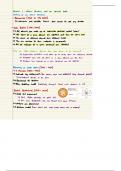Summary
Summary Edexcel A-Level Chemistry : Unit 1 - Atomic Structure and the Periodic Table Notes
- Course
- Institution
- Book
These revision notes for Edexcel A-Level Chemistry Unit 1 cover atomic structure and the periodic table in detail. Key topics include the properties and significance of subatomic particles, the principles of electron configuration, and the trends observed across the periodic table. Additionally, th...
[Show more]





